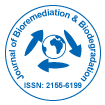Special Issue Article
Use of Dissolved Organic Carbon to Biostimulate Rapid Rhizodegradation of Perchlorate in Soil
Dawit D.Yifru1 and Valentine A. Nzengung2*
1Geosyntec Consultants, 1255 Roberts Blvd. Suite 200, Kennesaw, GA 30144, USA
2Department of Geology, University of Georgia, Athens, Georgia 30602, USA
- *Corresponding Author:
- Valentine A. Nzengung
Department of Geology
University of Georgia, Athens, Georgia 30602, USA
Tel: 706-542-2699
Fax: 706-542-2425
E-mail: vnzengun@uga.edu
Received March 26, 2012; Accepted March 16, 2012; Published March 18, 2012
Citation: Yifru DD, Nzengung VA (2012) Use of Dissolved Organic Carbon to Biostimulate Rapid Rhizodegradation of Perchlorate in Soil. J Bioremed Biodeg S7:003. doi: 10.4172/2155-6199.S7-003
Copyright: © 2012 Yifru DD, et al. This is an open-access article distributed under the terms of the Creative Commons Attribution License, which permits unrestricted use, distribution, and reproduction in any medium, provided the original author and source are credited.
Abstract
The main limitation to biodegradation of perchlorate in most soils and groundwater tends to be the availability of an adequate supply of organic carbon or electron donors. This study investigated the use of electron sources provided as Dissolved Organic Carbon (DOC) from chicken litter extract and acetate to enhance and sustain rhizodegradation of perchlorate in contaminated soils. This approach should reduce the residence time of perchlorate in vegetated soils and minimize the well-documented plant uptake of perchlorate at contaminated field sites and by food crops. Willow trees (Salix nigra) planted in 20 L soil bioreactors were dosed with perchlorate-contaminated water multiple times. The rate of biodegradation of perchlorate in willow-planted soil bioreactors provided with electron sources as 300 mg L-1 DOC was very rapid and described by zero-order kinetics with a maximum rate constant of 24 mg L-1 day-1. For planted control experiments in which DOC was limiting, the removal of perchlorate primarily by biodegradation was described by pseudo-first-order kinetics with a maximum rate constant of 0.35 day-1. The fraction of perchlorate phytoaccumulated in the control plants was an order of magnitude higher than in plants grown in the DOC-dosed bioreactors. The results of this study confirms that the slow buildup of DOC in the rhizosphere by root exudation and organic matter decomposition is insufficient to sustain a high rate of biodegradation and/or rhizodegradation of perchlorate and perhaps other degradable contaminants in vegetated contaminated soils. It is recommended that an optimum design of phytoremediation of perchlorate should include enhancement of rhizodegradation by providing an optimum and sustained supply of carbon source.
